

Classic Buses Profiles
Eastbourne Corporation seafront buses (by Dick Gilbert)
Last updated 6 September 2022

SOME LINKS WITHIN THIS WEBSITE: Home Email Links THE COMPLETE WEBSITE MENU Events Diary Halfcab list Small-Ads Classic Irish Buses Classic Manx Buses
Another look at some delightful vehicles from the past. This time we go to Eastbourne again, and look at some of the vehicles that have been used to transport happy holidaymakers up and down the picturesque seafront there.
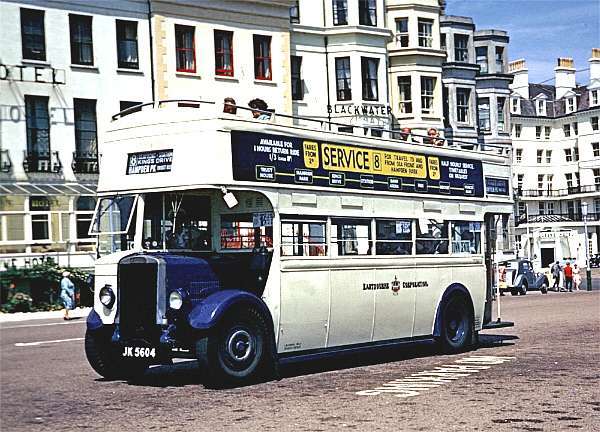
Eastbourne Leyland Titan TD4c No. 94 (JK 5604) White Heather at the pier in 1960. Photo by kind permission of Eamonn Kentell.
Eastbourne in Sussex holds a very special place in the history of bus transport, because its Corporation was the first municipality in the world to receive consent for a motor bus service. Their first vehicle, a 14-seat Milnes Daimler, commenced operations in April 1903, which was even before the days of registration number plates.
The town's bus service, later known as Eastbourne Buses, exceeded 100 years of continuous operation before its takeover by Stagecoach in 2009, and certainly operated a wide variety of interesting vehicles around the delightful and attractive resort, ranging from Clarkson steam buses and open-top De Dion Boutons to gearless Leyland Titans, but it is the seafront buses that are the subject of this page.
In the 1920s and 1930s a variety of conventional buses were used for this purpose but, post-war, most of them were open-top, and offered services to various parts of the town as well.
Most of those listed below were conversions of ageing double-deckers, the work usually being done in the Corporation's own workshops in Churchdale Road (now closed). It was not until the 1960s that vehicles were purchased off the shelf for seafront use, with the arrival of a batch of Regent Vs with full-drop windows and a full-length translucent roof. We end the list (reluctantly) with a particularly ugly bus with a daft name, a sad end to a glamorous era.
In my youth I remember well the delight of travelling on the open-top buses around Eastbourne - it was a real treat for us children. On summer days one could pretty well rely on finding them on route No. 6 which started at the railway station, travelled up to Meads in the west of the town, past the foot of Beachy Head (actually not at the bottom of the cliff, but at the point where the western end of the seafront meets the rising hillside), along the full length of the seafront to Princes Park (where a miniature tramway operated) and back again.
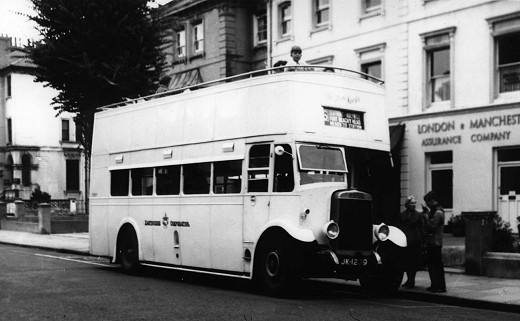
The White Knight (no. 64, JK 1239) waiting in Gildredge Road to depart on Route No. 6 in the 1950s. Is that you upstairs at the front - or is it me!? (Photographer not known, but kindly sent by Dave Bran)
Apart from the delight of having the wind blow in one's hair as the bus trundled along, the part we liked most was coming down from Meads towards the town on the way back. The bus would stop at St. John's Road, and then plummet down through a tunnel of trees covering a dual carriageway portion of the road heading to the Saffrons Cricket Ground and the Town Hall. Overhead branches would swipe at the bus as we went along and it was quite possible to grab leaves as they rushed by. In retrospect this was a bit dangerous I suppose, but we loved it.
In fact the Corporation would regularly lop these trees and they used the open-top buses to achieve this. I have a photograph of no. 95 White Ensign at the Churchdale Road depot in the winter of 1962/63 with a scaffold-pole trestle arrangement on its roof for this purpose. The bus had been withdrawn from passenger service by this time, and it was probably only the tree-lopping function that kept it around so late in its life - it was 25 years old by that time. I was pleased to discover that this machine still survives.
"White Ensign" looked old with its very flat, upright front, but not nearly as dated as the more recent Regent II batch (Nos.6-10) of 1938, which were just being retired at the time and had a decidedly ancient appearance. The TD1s and TD2s looked even older, with the TD2s still retaining the 'piano front' - a style that had been out of fashion since the 1930s.
The people of Eastbourne were very familiar with the names the White ----- which were used between 1949 and 1963, and the buses became almost town mascots. Many were probably not aware, however, that some names were used twice during this relatively short period, with the first series being withdrawn in the mid-1950s and replaced with other vehicles using the same names. (Numbers 94 and 95 omitted the word the before the name, for some reason.)
A brief explanation of the Eastbourne Corporation numbering system would not go amiss. Basically, they simply numbered vehicles from 1 upwards, but no numbers over 100 were permitted. Therefore, when the sequence looked like approaching 100, they started again. The series therefore eventually went round for the fifth time, but then continued beyond 100.
This means that a list in numerical order would be confusing, so it is instead arranged in date order. Some numbers were changed occasionally to allow new batches to fit into the system, and very old vehicles that were still in service when the sequence was going round again sometimes resulted in gaps or changes, but this will be explained as we go along.
The Southdown enthusiasts club has kindly given me permission to use some information from their publication "Eastbourne Borough motor buses - the first 80 years published in 1983. My thanks to them for this, which has been of great assistance in preparing this page. I must also acknowledge the invaluable help provided by various PSV Circle publications.
As with my other lists, the mistakes are bound to creep in, and some relevant information may be missing so, in order to make it as accurate a reference as possible, I would of course welcome any additions or corrections.
FLEET LIST
LEYLAND TITAN TD1 - 64 and 75 (total 2)
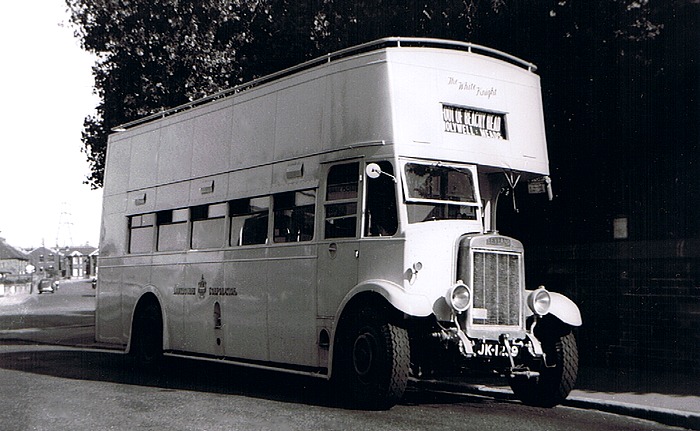
Leyland TD1 No. 64 the White Knight (JK 1239) in the early 1950s at the bottom of Churchdale Road. Photo from the Colin Routh collection by kind permission.
Built in 1930 and 1931 respectively.
Chassis: Leyland Titan TD1.
Body: Originally Leyland H48R double-deck bus bodies, rebodied by East Lancs in the 1940s to H30/26R, then rebuilt in the Corporation workshops in 1950 to open-top O30/26R.
Notes: Numbered in the second cycle. These vehicles were two of sixteen Titan TD1s acquired in 1930/31, the remainder of which had all gone by 1950. Even after rebuilding they still looked very dated with old-fashioned sturdy radiators and protruding headlamps. They were painted all white with no lining.
LEYLAND TITAN TD2 - 77-80 (total 4)
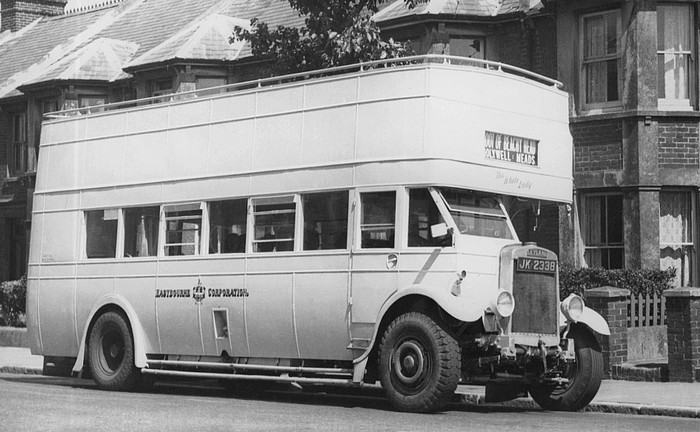
The White Lady no. 80 around 1950, possibly in Channel View Road. (Photo: Roy Marshall Collection, via East Pennine transport group, Huddersfield)
Built in June 1932
Chassis: Leyland Titan TD2
Body: Originally Leyland H48R double-deck bus bodies, rebuilt in the Corporation workshops in 1949 (no. 79 in 1950) to open-top O28/24R.
Notes: Numbered in the second cycle. Like the previous batch, they looked very dated with a steeply- sloping cab windscreen and the piano-front still in place. They were originally painted completely white.
LEYLAND TITAN TD4 - 94-96 (total 3)
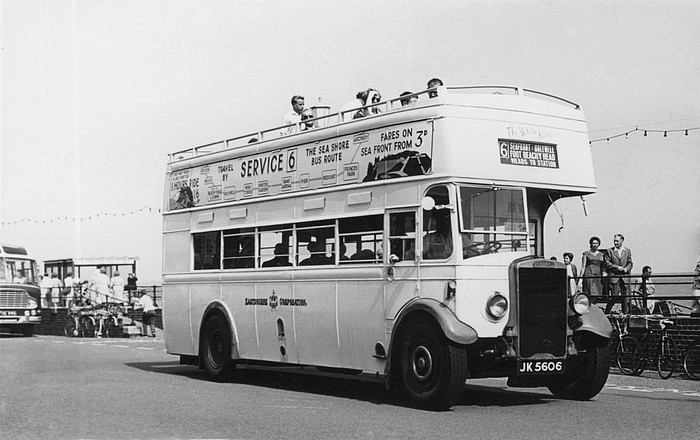
The White King (no. 96) on the seafront around 1960 (Photo: R.F.Mack)
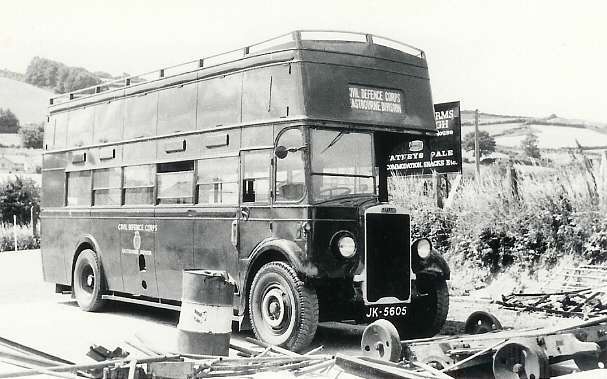
No. 95 (JK 5605) seen at the Dart Valley Railway in 1970, still in its dark green Eastbourne Division Civil Defence Corps livery. Photo by Peter Esposito, via Chris Stanley.
Built in 1936-37
Chassis: Leyland Titan TD4c
Body: Originally Leyland H48R double-deck bus bodies, rebuilt in the Corporation workshops in 1952 (no. 96 in 1956) to Open-top O28/24R (no. 96 to O30/26R)
Notes: Numbered in the second cycle. Two of this batch had the word the omitted before the name. They were white with blue bonnets and mudguards.
LEYLAND TITAN TD5 - 2 (total 1)
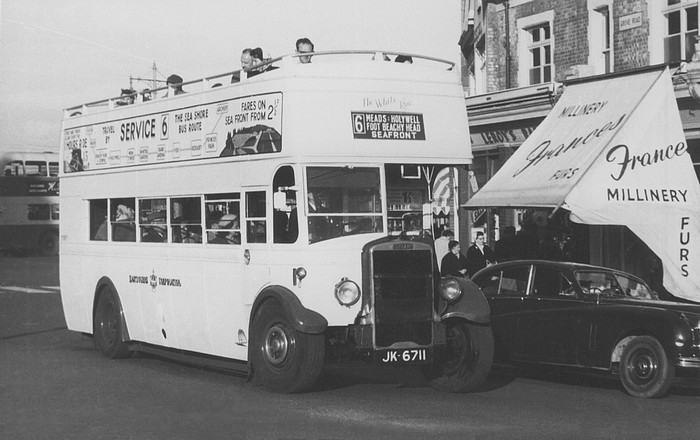
No. 2 (JK 6711) turns from the railway station up Grove Road to start its circular tour on route 6. This was the only one of the five 1937 Titan TD5 buses to be converted to open top. To see a picture of this bus before its conversion to open top, click here. Photo: unknown
Built in July 1937
Chassis: Leyland Titan TD5c
Body: Originally Leyland H48R double-deck bus body, rebuilt in the Corporation workshops in 1956 to open-top O30/26R.
Notes: Numbered in the third cycle.
AEC REGENT II - 6-10 (total 5)
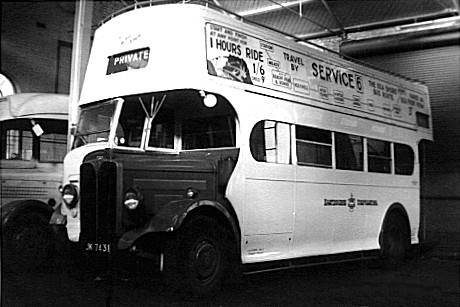
No. 10 White Knight at Churchdale Road garage, 1961. (Photo Dick Gilbert)
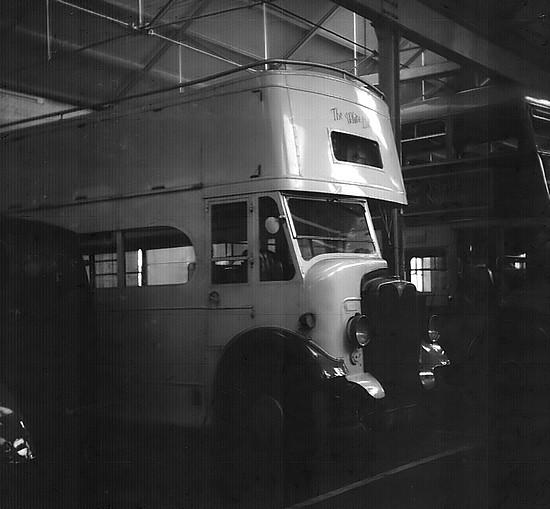
No. 8 White Lady, withdrawn and decomissioned at Churchdale Road garage, 1961. Not a great photo, but still interesting as it may be the last picture taken before it was sent for scrap. (Photo Dick Gilbert)
Delivered August 1938
Chassis: AEC Regent II 661. Nos. 7 to 10 had 8.6 litre oil engines fitted in 1954 (see notes below).
Body: Originally Northern Counties H24/24R double-deck bus bodies, rebuilt in the Corporation workshops in the 1950s to open-top O28/24R. The rounded ends to the windows on the lower decks were retained.
Notes: These are believed to be the last AEC Regent buses delivered with petrol engines. Numbered in the third series. Painted white with blue bonnets and mudguards.
Eastbourne Corporation bought 12 vehicles from Southdown in the early 1950s (probably TS7 Tigers), in order to use their Leyland 8.6 litre diesel engines, nos. 7 to 10 received these engines in 1954, while no. 6 was given a 9.6 litre AEC engine.
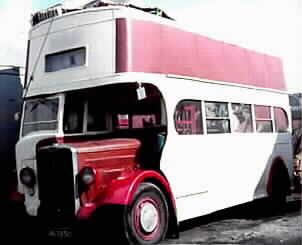
JK 7430 (no. 9) as a fairground vehicle in Birmingham, 1961 (Photo; Roger Hardy)
LEYLAND TITAN PD1 - 13-18 (total 5)
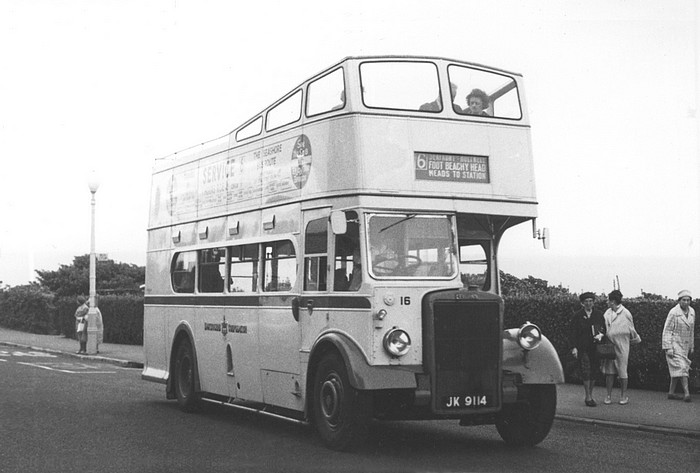
No. 16 (JK 9114) in the mid 1960s at Holywell, heading up to the foot of Beachy Head (Photo: unknown)
Built in 1946
Chassis: Leyland Titan PD1
Body: Originally East Lancs H56R double-deck bus bodies, rebuilt in the Corporation workshops in 1961-63 to open-top O30/26R.
Notes: Numbered in the third series, this was originally a batch of six, but no. 15 retained its roof throughout its life and is therefore not included in the list.
With the 1930s Leyland Titans and Regent IIs getting long in the tooth, it was decided to convert some of the post-war Leyland PD1s to take over their duties. New Regent V double deckers were coming into service so the East Lancs-bodied batch of Titans could be spared from normal town work.
These conversions were again completed in the Corporation bus workshops in the Churchdale Road depot, but differed in some ways from their predecessors. For one thing, none of them was named - perhaps a pity. After all, the names had become a bit of an Eastbourne tradition and, if new names were becoming a mental struggle, no-one would have objected to some of the old names (now becoming available again) being recycled on the new buses.
(Evidence that names WERE becoming a struggle is provided by the tacky seafront sunbus of 1973, of which more later. Fortunately the tradition was re-established in more tasteful fashion in 1985 when two ex Ipswich Leyland Atlanteans (65 and 66) were rebuilt in the Corporation workshops to open-top configuration and named Eastbourne King and Eastbourne Queen.)
The most obvious change was the introduction of windscreens around the front of the upper deck. This feature immediately identified this particular batch, and many felt that it was a stylish and tasteful piece of work.
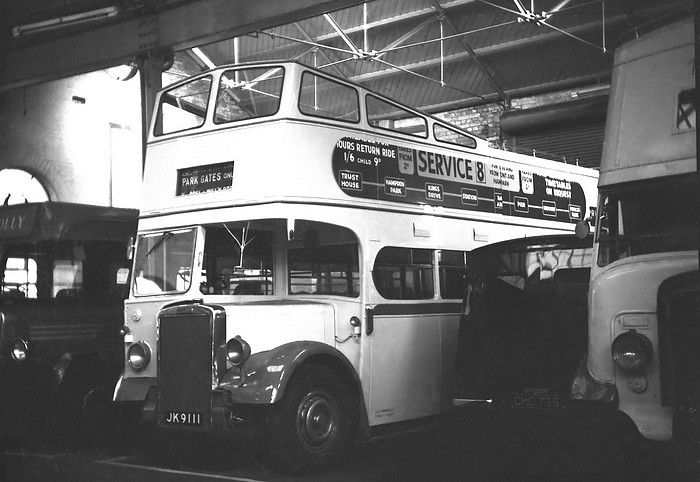
No. 13 (JK 9111) at Churchdale Road garage in January 1962, immediately after conversion to open- top and before entering service. (Photo: Dick Gilbert)
AEC REGENT V - 56-60 (total 5)
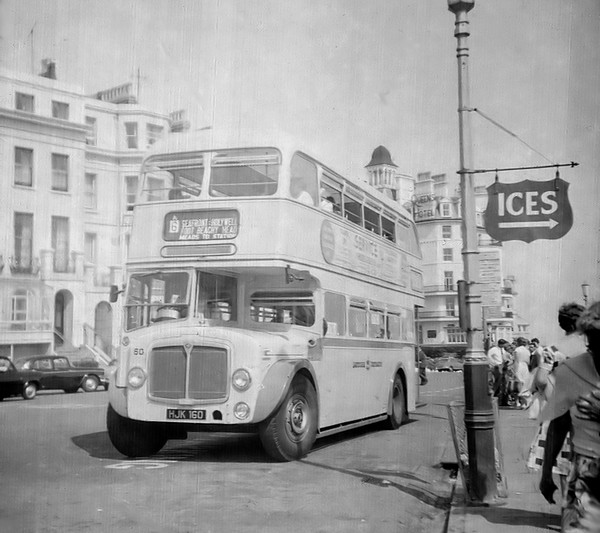
No. 60 at the pier in 1962. The translucent roof can be seen. (Photo: Dick Gilbert)
Delivered May-June 1961
Chassis: AEC Regent V, 2D3RV, 27 feet long, 8 feet wide, 9.6 litre engines.
Body: East Lancs H32/28R. The upper deck had translucent roof panels and full-drop opening windows. Platform doors were fitted to three of this batch in 1968 for use on town tours.
Notes: Delivered in cream/light blue livery. Each chassis cost £2,768.
Numbered in the third series, this batch of five was delivered during the period when the registrations meant something. The first digit of the number represented the year of delivery, and the other two the fleet number.
With their full-drop upper deck windows and translucent roofs, this batch was acquired specifically for seafront services, and were therefore painted in the traditional cream with subtle blue lining and mudguards. They were intended to replace the ageing open-top Titans and Regents, while providing a degree of shelter for those occasional rainy days!

No. 84 on the seafront. Photo by courtesy of Adrian Clarke
Built in June 1967
Chassis: Leyland PD2A/30
Body: East Lancs H32/28R double-deck fibreglass bus body rebuilt in 1973 to open top by merely removing the top of the roof, leaving all the upper deck windows in place.
Notes: Numbered in the fourth series, this bus was one of a batch of fifteen Leyland PD2As delivered in 1966/67 with (in my opinion) rather inelegant fibreglass front bodies. Like the batch listed above, they were delivered during the period when the registrations meant something. The first digit of the number represented the year of delivery (with the new year-letter suffix coming into use, this became unnecessary and was soon dropped), and the other two digits representing the fleet number.
With the last of the Titan PD1 batch (13-18) having been withdrawn in 1968, the seafront services had subsequently been operated by closed-roof buses only, and this conversion was intended to rectify the situation.
Initially coloured pale blue throughout, it was repainted in the traditional cream with blue lining in 1979. It was named the seafront sunbus, and the less said about that the better.
TOTAL 26 ( with 5 Survivors )
=======================================
======================
For such a long-established undertaking, the introduction of route numbers came very late in Eastbourne Corporation's bus operation. Route indicators and blinds were often unconventional, at one stage using black letters on a white background. The boxes were usually small, and provided only the most basic of information, but this was quite acceptable to the people of Eastbourne who knew perfectly well what the bus intended to do.
Even when, in the 1940s, route numbers were half-heartedly introduced, it was not always immediately apparent to the uninitiated what they signified. For example, to understand the subtle difference between a 1/4 and a 4/1 was something that took proper training.* As the numbers started to filter into use they were usually white numbers outlined with white boxes on the black background, although plain, large white numbers were also sometimes used.
(* The meaning was that a 1/4 set off as a 1 {to Old Town} but returned as a 4 {via Eldon Road and Ocklynge}, whereas a 4/1 went round the other way. These two routes were neither a proper 1, nor a proper 4.)
In the 1960s the scheme changed, and the numbers became black in little white square boxes. But this did not last very long and, by the late 1960s, everything had reverted to simple large white numbers - which was where it had all begun.
The seafront routes were popular from the earliest days, and some types such as the small batch of Dennis G single-deckers were purchased specifically for that duty. The route itself has changed somewhat. In the very early days a service ran from the Railway Station up The Avenue, over the railway and Seaside, reaching the seafront at the Redoubt. From there it proceeded west along the full length of the parades, past the pier and Holywell to the foot of Beachy Head, returning via Meads to the Station.
Fifty years later the service (now numbered route 6) still started at the Railway Station, and ran up to Meads and the foot of Beachy Head, before turning east the full length of the (now longer) seafront past the pier and Redoubt all the way to Princes Park Gates. There, a little pirouette around the block pointed it back east again to retrace its steps to the Station once more.
The journey on the no. 6 route could be started and ended at any point, and cost 1 shilling and 6 pence for adults, or 9 (old) pence for children. When the sun was out, the open-toppers could also be seen on different routes (particularly the no. 3 up to Old Town) - a pleasant surprise in other parts of the town.
These days the service is strictly seafront only. Now numbered route 3 (route 6 finally ceased in 1984), it traverses an even longer route, starting at the Sovereign Centre in what is now a thriving area, but had previously been a vast, unused shingle wasteland beyond Princes Park. From there it runs along the front, past the Pier and Holywell, to the foot of Beachy Head and then - on a part of the route that had been Southdown territory for donkey's years - up to the top of Beachy Head. It then returns along the same route.
An additional (although intermittent) service no. 8 also frequently used open-top buses; this ran from Grand Parade to the railway station, and then via Kings Drive to Hampden Park.
The Southdown service to the top of Beachy Head had been part of a long-standing agreement between them and the Corporation which kept the Corporation buses strictly within the town limits. This gave Southdown the right also to operate a seafront service (Route 97) from their Royal Parade garage near Princes Park, but one which was heading eventually up the steep hairpins to the top of Beachy Head or, in the case of the route 197, onward to Birling Gap, returning via East Dean and through the town centre. A similar Southdown open-top route ran from Brighton to Devil's Dyke.
Southdown also operated some interesting vehicles on the seafront. Initially the agreement permitted only single-deckers to be used by Southdown, the most glamorous of which were four 6-wheel Leyland Tigers (two TS6T and two TS7T models), 40-seaters with folding roofs, which survived until the 1950s. These machines can only be described as fabulous! Open top conversions of wartime Guy Arabs were then used when the restriction on the use of double-deckers was lifted, but this is all dealt with in more detail on the Southdown Guy Arab page.
For more Eastbourne buses see the double deckers, single deckers, photo album, and also the Southdown Guy open-toppers.
For many other buses, have a look at all the other profiles on the Classic Buses menu page.
SOME LINKS WITHIN THIS WEBSITE: Home Email Links THE COMPLETE WEBSITE MENU Events Diary Halfcab list Small-Ads Classic Irish Buses Classic Manx Buses